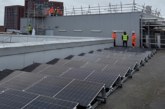Goodman Masson and Q-Bot ran a very well-attended webinar on Tuesday 15th March tackling the big challenge of retrofit, acquiring government funding and how to make it work for every stakeholder. The panel of experts included Matt Harrison from the Department for Business, Energy and Industrial Strategy (BEIS), Tania Jennings from Ealing Council, Russell Smith from Parity Projects, and Leigh Fairbrother from Q-Bot.
Millions of homes will be retrofitted over the next 30 years to become net zero carbon. The UK Government has set a target for as many homes as possible to be EPC rated ‘C’ by 2035 and a near complete decarbonisation of homes needs to be achieved by 2050 as nearly 80% of current buildings that will exist in 2050 have already been built. This will mean healthier, greener and more energy-efficient homes, benefitting the planet, homeowners, social and private landlords, local communities and tenants.
Retrofitting existing homes effectively, reliably, and efficiently is an immense challenge fraught with cost overruns and unintended consequences. To deliver retrofit at scale the industry needs to build a detailed understanding of the factors that influence success and implement feedback loops to share lessons learned.
Overview of the panel discussion
Matt Harrison provided an overview of the policy context, funding landscape and how social landlords can best present their case. Matt insisted that we need to tackle carbon emissions and fuel poverty at the same time, and this will be achieved by developing a dedicated retrofit supply chain.
The Government has recently announced a new wave of funding, amounting to £800m. Similar to previous funding, it will be released in several waves with a three-year window to deliver the work. The competition bid will be opened in the summer for social landlords to apply. Matt reinforced that BEIS is funding the Social Housing Retrofit Accelerator, which provides free support to all social landlords across the country to submit their bid, including one-one support, workshops, and webinars.
Matt specified that the sector has learnt a lot from previous rounds of funding that is currently being integrating into future waves.
Retrofitting isn’t easy, but failure isn’t an option either. Social landlords need to understand how they can upgrade their housing stock to the energy standard, while putting the welfare of their resident in the centre of their action.
Russell Smith explained the importance of having reliable data to make the right decision — what are the best properties to be upgraded first/which measure(s) to install first to achieve the energy standard, doing it in the most cost-effective way. Delivering retrofit projects at scale involves knowing what to spend budget on, making an informed decision, using funding, and working with residents to implement measures in the least disruptive way.
Parity Projects is developing a national database of housing data highlighting energy and carbon emissions associated with housing. Data comes from the Energy Performance Certificate (EPC), additional survey (in-house and external surveyors) and other databases. Around 18m houses, from the social and private market, are currently under analysis.
This provides a platform to showcase the state of existing housing stock and run different upgrade scenarios. Hence a property owner can understand which properties are performing better than others and pick the best scenario to end up with a package that is already set up and waiting to be procured and then executed. This is particularly useful to target specific properties and mostly vulnerable people (especially following the rise of energy).
Tania Jennings shared her knowledge and experience in acquiring a large amount of funding. The coalition of several local authorities in the South West of London obtained more than £38m of government funding though the GHG-LAD phase 1A, 2 and 3, and HUG phase 1.
Tania explained that one of the biggest challenges is to understand how to use data. In fact, data is very useful, but it doesn’t tell you what to do. Tania said: “My C rated house is not the same as every C rated property.”
It is also key to know your intervention points in a retrofit project. For example, the team identified that a heat pump will be installed when there is no tenant living in the house or when the boiler is due to be replaced. However, installing a heat pump should only be done if the house is insulated in the first place. Otherwise, the funding isn’t spent where it should be.
Tania is using Parity Project’s data, which has been essential in knowing what they need to about their housing stock, and how they can address these properties. More importantly, this allowed her to understand where people in fuel poverty live and ask for specific funding for those specific properties — a model that has proved to be successful.
Leigh Fairbrother had a supplier’s perspective, highlighting key retrofit challenges to suspended floors and how to overcome them. Leigh explained how the installation of underfloor insulation can be very difficult, time-consuming, and expensive. People are usually resistant of using traditional methods because of the disruption involved. To tackle this challenge, Q-Bot has commercialised a unique system to retrofit suspended floors using a robotic device to remotely apply insulation.
With the help of an in-house business intelligence team and AI software technology, Q-Bot can analyse property lists using information available from several sources to provide social landlords with valuable energy performance data and find the most suitable properties for its robotic underfloor insulation.
Q-Bot already has a strong impact on improving energy efficiency, working in thousands of homes across the UK. The benefits of insulating the floor with Q-Bot result in a reduction of one third of cold draughts across the whole house, lower energy bills and carbons emissions, improve value of the property and EPC rating.
Recording of the session available now: https://www.youtube.com/watch?v=g7qIFRw_RlY
Header image: Q-Bot uses robots to inspect and spray insulation under the floor in homes.









